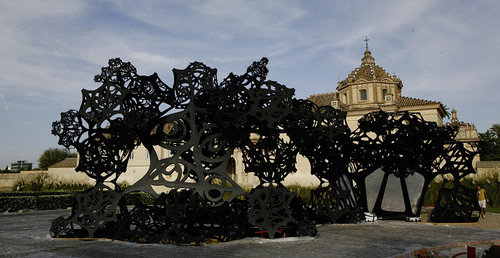The Morning Line
dal 1/10/2008 al 10/1/2009
Segnalato da
Thyssen-Bornemisza Art Contemporary
1/10/2008
The Morning Line
Centro Andaluz de Arte Contemporaneo, Sevilla
A new experimental project by Matthew Ritchie designed with architects Aranda\Lasch and Daniel Bosia of Arup Advanced Geometry Unit, commissioned by Thyssen-Bornemisza Art Contemporary, which explores the interdisciplinary interplays between art, architecture, mathematics, cosmology, music, and science. Unlike traditional architectural pavilions, it takes the form of an open cellular structure rather than an enclosure, basing its eloquent visual language on a radical cosmological theory developed by Paul Steinhardt and Neil Turok.

Curated by Daniela Zyman and Francesca von Habsburg
The Morning Line is a groundbreaking new experimental project by Matthew Ritchie designed with architects Aranda\Lasch and Daniel Bosia of Arup Advanced Geometry Unit, commissioned by Thyssen-Bornemisza Art Contemporary, which explores the interdisciplinary interplays between art, architecture, mathematics, cosmology, music, and science. Developed since 2004 as a research / investigation for a new pavilion The Morning Line is challenging architectural convention: The team of collaborators has designed the first semiasographic building, an architectural language that directly expresses its content through its structure – a structure that is simultaneously generating itself and falling apart, enclosing an interactive environment inside which a possible future can be seen – and changed.
The foundation’s second architectonic commission inaugurates as part of the 3rd International Biennial of Contemporary Art of Seville in Spain. The opening premieres collaborative compositions which are being created by Bryce Dessner in collaboration with David Sheppard and Evan Ziporyn, Riceboy Sleeps (Jón Thór Birgisson and Alex Somers), Mark Fell in collaboration with Roc Jiménez de Cisneros, Florian Hecker, Bruce Gilbert, Lee Ranaldo, Thom Willems, and Chris Watson.
The Morning Line is both ruin and monument, the blackened frame of a cathedral-like structure; a drawing in and of space; an ‘anti-pavilion’. Unlike traditional architectural pavilions, it takes the form of an open cellular structure rather than an enclosure, basing its eloquent visual language on a radical cosmological theory developed by Paul Steinhardt and Neil Turok.
Built from an idealized ‘universal bit’ that can be reconfigured in to multiple architectural forms, The Morning Line uses fractal cycles to build a model of the universe that scales up and down. The architectural and engineering systems capitalize on recent developments in parametric design developed by Arup AGU, and push them to their limits. There is no single way in or out, no final form. The Morning Line's narrative by Matthew Ritchie revisits John Milton’s “Paradise Lost” to propose a new kind of place that might exist after the second ‘fall’ of mankind – while at the same time acknowledging the unpredictable nature of such a future. Deep inside the structure, an interactive film describes the evolution of the universe as a story without beginning or end, only movement around multiple centers.
A platform for contemporary music, The Morning Line is as much an instrument as a building, saturated with speakers, using a unique interactive ambisonic system designed by Matthew Ritchie and the Music Research Centre at York University. Thyssen-Bornemisza Art Contemporary designated the The Morning Line to be a modular structure, which is capable of being radically reconfigured for alternative performance venues and can adapt to a changing program of contemporary music.
The interactive system registers the movement of anyone inside and converts their presence to build new and scaleable forms of music, new stories created by every visitor. It offers a site primarily concerned with generating infinite potential meanings and uses. In other words, it is not only designed for the future, it creates it.
Commissioned by Thyssen-Bornemisza Art Contemporary
Produced by T-B A21 production department: Philipp Krummel, Barbara Simma, Ivan Stocker
Conception and design: Matthew Ritchie
Architecture and engineering: Aranda\Lasch (Benjamin Aranda, Chris Lasch, Clay Coffey) with Arup AGU (Daniel Bosia, Nicolas Sterling) and Matthew Ritchie Studio (Mike Koller, James Case)
Music curators: Bryce Dessner and Florian Hecker
Commissioned compositions by Bryce Dessner in collaboration with Matthew Ritchie, David Sheppard and Evan Ziporyn, Mark Fell in collaboration with Roc Jiménez de Cisneros, Bruce Gilbert, Florian Hecker, Lee Ranaldo, Riceboy Sleeps (Jón Thór Birgisson and Alex Somers), Chris Watson and Thom Willems
Sound spatialization design: Tony Myatt (Music Research Centre/York University), Aranda\Lasch, Matthew Ritchie and David Sheppard
Software system programming: Music Research Centre/York University, Tony Myatt, Matthew Paradis, Peter Worth, Theo Burt, David Malham
Interactive programming: Media Interakt
Animation & animation programming: Matthew Ritchie, Nick Roth, James Case
Cosmological interpretations: Matthew Ritchie and Aranda\Lasch (based on models proposed by) Johannes Kepler, John Milton, Gerard t’Hooft, Paul J. Steinhardt and Neil Turok
Fabrication: Sheetfabs, Nottingham
Press Office
Thyssen-Bornemisza Art Contemporary
press@tba21.org / http://www.tba21.org
T +43 1 513 9856 29 / F +43 1 53 9856 22
Centro Andaluz de Arte Contemporaneo
Monasterio de la Cartuja de Santa Maria de Las Cuevas, Avda. Americo Vespucio 2 - Sevilla



